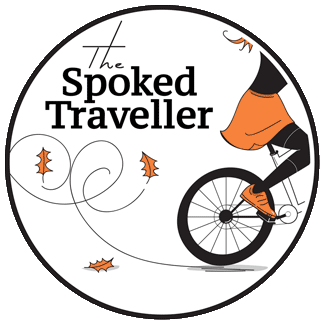26 Mar Trans–Sardinia, Italy
SOMEWHERE ON A BICYCLE IN SARDINIA—“Why you no marry, Bella?” asks the tiny Italian shepherd with no teeth.
As the first Canadian, and only woman on this ride (six Italian men and one Norwegian), I stand out. Called Transardinia, during this epic eight-day journey I will climb a total elevation of 11,000 metres—but for now–I can’t stop thinking about that cow.
Walking my bike over the jutting limestone rocks, I hear: “She’s giving birth.” It is Bjornar, the Norwegian powerhouse who leads our group up the mountains most days. He calls me over. Sure enough, two legs are protruding from mommy cow. She lays down amongst the twisty cork trees and lets it happen.
Somehow a cow giving birth doesn’t seem out of place in the wild back country of Sardinia, but a girl riding it does. Surrounded by uber athletic type-A personalities on expensive bikes, I feel like I have something to prove—if not for me than all female cyclists.
Transardinia is the brainchild of a Giorgio Pupillo, a pilot who envisioned a ride starting in Olbia in the north, traversing south through forests, mountains, rivers, and desert to the city of Cagliari—450 kilometres later. In 2005 it became an organized ride with the help of Amos Cardia, our guide, and Ichnusabike Company; each year they offer two rides in the spring and two in the fall when the weather is mild.
On the first day—52 kilometres from Olbia to Oliena—most of the men are wearing jerseys with team logos; everyone is busy tweaking their forks, brakes and lubing up their chains. My jersey has a picture of Snoopy and I’m riding a rental bike—no tweaks necessary.
Starting out, the landscape feels prehistoric: there are more sheep than people and there’s a definite presence of former civilizations Our first taste is only minutes into the ride.
Called the Tombs of Giants of Su Monte S’Ape, the mossy black tombstones in this Nuragic cemetery date back to 1800 BC. “The family of the dead used to come here and bring gifts to the dead,” says the guide.
Across the road, a castle is equally ominous: the top half of the turret is hidden in a gray storm cloud. This was once a defense post around the 1200s when Sardinia was a kingdom.
Leaving the cemetery, we begin our ascent—an unending corkscrew up the mountain; three hours pass. Eventually the switchbacks get shorter. The rock plateau, Alà dei Sardi, overlooks the intense green forest below. It’s silent except for the wind that threatens to knock me off the rock. I spot the Norwegian—he pounds his chest like an ape and explains: he’s the first to the top. I’m second: I pound my chest, too. Turns out I’m not the slowest.
When the others arrive, I sense their surprise and respect that I have passed them. Marco—one of the riders unable to finish the first day— makes me a sandwich. “Bella, you ride good,” he says, piling on the prosciutto.
On the tailgate of the truck there’s a spread of pomodoro (tomatoes), figs, and mounds of tissue-paper-thin prosciutto—all locally cured. I pull out the fatty ham. It melts on my tongue like salty cotton candy.
Sardinian food hasn’t changed much since the medieval times, especially in the interior where meat dominates the menu; the meat is the third and final plate served after antipasti and pasta, of course. That night we eat a pig—all of it. Nibbling on the ear, I make sure to avoid the hair inside, but I devour the gobs of white creamy fat—I’m riding after all. Massimiliano Napolitano,a doctor from Rome, who I call Zorro for short, pulls out his neck gesturing that he’s gaining weight: “Uggg, Transardinia,” he says in a deep voice. I agree, but I don’t care.
If the trail had signs we might be able to predict the length of our ride, but every day is long, often getting to our farm house or bed and breakfast at 7 p.m. or later. Amos uses a GPS to navigate us through cow patties, over fences, across rivers and up the mountains. But this year, there’s also unseasonal rain and cool weather.
On the second day, we have to stop early because the mud is jamming up our brakes and gears; we find refuge in a bar. Immediately everyone starts to peel off socks and jerseys, draping them over the stone fireplace. “You need drink?” asks the owner, pouring before getting a response. Downing shots of pompia, a liqueur made from citrus, it burns on the way down. By this time I have squeezed into a corner of the fireplace—any closer and I would be in it.
By day three the weather has improved—somewhat.
For lunch we stop at Su Suercone, Europe’s largest rock crater; our guide explains that during the 1970s bandits kidnapped wealthy people and brought them here. “No one will find you here—not even the police,” says Amos.
By day four the cold rain has returned, but there’s hope: at the bottom of the mountain is the prosciutto-filled pickup truck and one of the guys drying his socks over a homemade fire.
Zorro points at the pigs walking by: “They no pay for this. Why? Why do we pay for this?” For the rest of the week, whenever the rain and climbs are too much, Zorro asks: “Why? Why?”
That night we commiserate about the cold over a fireplace—Amos slides a fist-sized chunk of pecorino cheese into the fire. It bubbles; pulling it out, he cuts a sliver and slides it onto a piece of crispy thin bread called pane carasau that shepherds baked to take on long travels.
Marco offers me his dessert of sabadas—a fried sweet ravioli drizzled with local honey. Heapings of respect for the girl rider. Food has meant so much on this ride—culture, sustenance, and now a much deserved reward.


Sorry, the comment form is closed at this time.